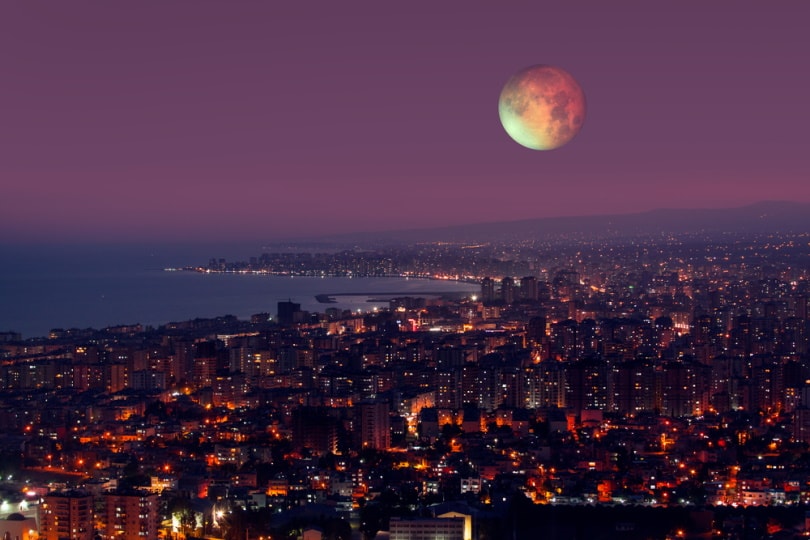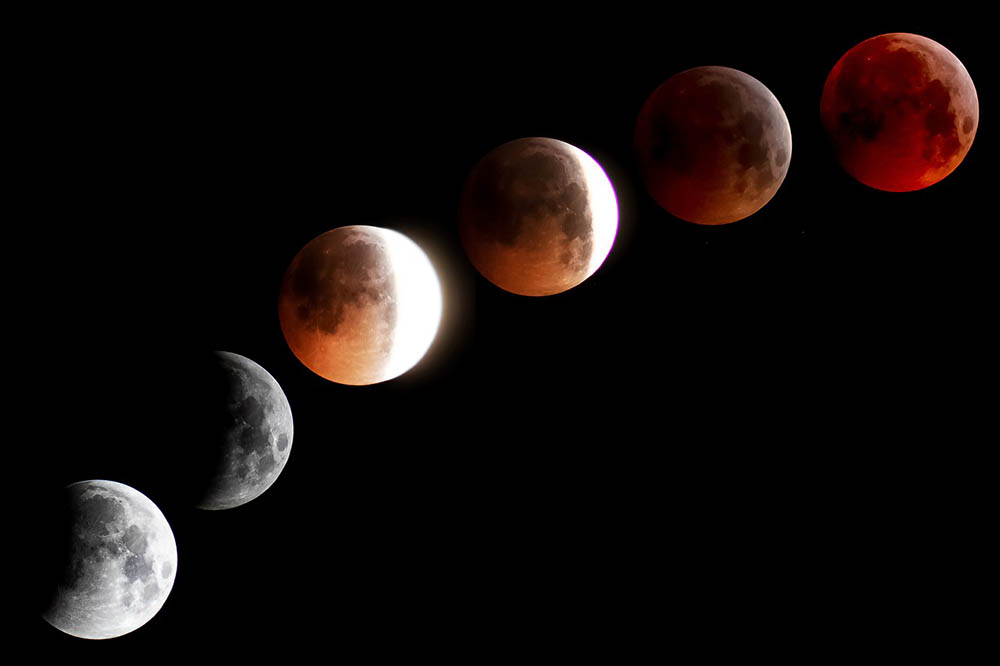What Is a Partial Lunar Eclipse?
Last Updated on

A lunar eclipse is whenever the Moon passes into the Earth’s shadow and appears totally dark as a result. If that’s a lunar eclipse, what exactly is a partial lunar eclipse? A partial lunar eclipse is similar to a lunar eclipse, but it isn’t entirely the same. That does not even begin to touch on the difference between a partial and penumbral eclipse.
In this article, we are going to learn what a partial lunar eclipse is, how it works, and when partial lunar eclipses occur. Keep reading for all of this and more.

What Is a Partial Lunar Eclipse?
To fully understand this question, you have to understand how the Sun, Moon, and Earth relate to one another. It’s most helpful to think of the Sun as the center of our Solar System. The Earth rotates around the Sun. This rotation around the Sun is what causes changes in the seasons.
At the same time, the Earth is rotating on its axis. This axis rotation starts over every 24 hours, and it is responsible for the day and night cycle. Whenever the Earth turns on its axis, it will be exposed to the moon during nighttime and the Sun during daytime.
Occasionally, the Earth will be positioned in such a way on its orbit around the Sun that it causes a shadow to go against the Moon. This shadow is responsible for the partial lunar eclipse. The Earth is positioned in such a way between the Sun and a full moon that part of the Moon falls behind the shadow.
So, a partial lunar eclipse is whenever the Earth moves between the Sun and a full moon. However, the planetary bodies are not precisely aligned, and a part of the Moon is visible, and the other part is covered as a result. In other words, only a part of the Moon’s surface will move behind the shadow.

What Are the Different Types of Lunar Eclipses?
There are three types of lunar eclipses: total eclipses, partial eclipses, and penumbral eclipses. Understanding how the three relate to one another can further clarify what a partial eclipse is.
Umbra vs. Penumbra
The first thing you need to know when understanding the three different types of lunar eclipses is the umbra versus the penumbra. Whenever the Sun is in front of the Earth, a shadow will be cast behind the Earth. The umbra and penumbra refer to different parts of the shadow.
The umbra is the darkest part of the shadow. It is found right behind the Earth. The penumbra is the wider region on the perimeter of the shadow. It isn’t quite as dark, and it is most important when discussing a penumbral eclipse.
Total vs. Partial vs. Penumbral Eclipse
So, how does a partial lunar eclipse differ from an actual lunar eclipse? What about a partial lunar eclipse compared to a penumbral eclipse?
The most observable answer is that the Moon will only be partially obscured under a partial lunar eclipse, but it will be completely obscured during a total lunar eclipse. However, both partial and total eclipses happen whenever the Moon passes into the Earth’s umbra.
This difference in appearance is caused by a difference in alignment. Whenever the Sun, Moon, and Earth are in proper alignment, that is when a total eclipse will happen. A partial eclipse occurs whenever the alignment is close but not yet perfect. As a result, the Moon is not entirely covered.
What about a penumbral lunar eclipse? Penumbral lunar eclipses happen whenever the moon moves into the Earth’s penumbra. This eclipse is often mistaken for just a regular full moon because it isn’t as dramatic looking. A penumbral eclipse actually begins and ends the partial and total lunar eclipses.
When Do Partial Lunar Eclipses Occur?

In order for a partial lunar eclipse to occur, the conditions must be right. There must be a full moon and the Sun, Moon, and Earth must be aligned in a mere straight line. If the conditions are right, partial lunar eclipses will follow in the stages below:
- A penumbral eclipse begins whenever the Earth’s penumbra begins covering the Moon’s surface.
- The partial eclipse officially begins whenever the Earth’s umbra begins moving over the Moon.
- A maximum eclipse will happen whenever the Earth’s umbra covers the largest portion of the Moon that it will cover during this eclipse.
- The partial eclipse will end whenever the Earth’s umbra is no longer covering the Moon.
- The penumbral eclipse will end whenever there is no longer a shadow cast on the Moon. This is the end of the entire eclipse.
Frequently Asked Questions (FAQs)

What is a partial lunar eclipse?
A partial lunar eclipse occurs whenever most of the Moon’s surface is covered by the Earth’s shadow due to its positioning against the Sun. The entire Moon’s surface is not covered, though.
Can partial lunar eclipses happen at any time in the moon cycle?
No. Partial lunar eclipses can only happen whenever there is a full moon, and the Earth, Sun, and Moon must be positioned in such a way that they are almost in a straight line.
Why don’t partial lunar eclipses happen more often?
Partial lunar eclipses do not happen more often than they do simply because the conditions have to be perfect. For starters, there needs to be a full moon, and the different planetary bodies have to be in a nearly straight line.
How is a partial lunar eclipse different from a total lunar eclipse?
A partial lunar eclipse is different from a total lunar eclipse because only part of the moon’s visible side is covered by a shadow. The entire visible side of the moon is covered in a total eclipse.
How is a partial lunar eclipse different from a penumbral lunar eclipse?
A penumbral eclipse happens whenever the moon passes through the Earth’s penumbra or shadow, but a partial lunar eclipse happens whenever the moon passes into the Earth’s umbra. The umbra is the darker region caused by the shadow, whereas the penumbra is the wider region. This explains why the penumbral eclipses don’t look much different from regular full moons.

A Quick Reference Guide
For further reference, here is a quick guide about the differences between penumbral, partial, and total eclipses.
| Eclipse Type | Occurs When | What It Looks Like |
| Penumbral | Full moon passes through the Earth’s penumbra | Darkened full moon |
| Partial | Full moon passes through the Earth’s umbra | Most of the moon is covered |
| Total | Full moon passes through the Earth’s | Visible side of the moon is completely covered |

Conclusion
Once again, a partial eclipse is whenever the Moon, Sun, and Earth are in an alignment that is close to a straight line. As a result, the Sun will pass through the Earth’s umbra, but the visible side of the Moon will not be completely covered in the shadow like it would with a total eclipse.
At the beginning and end of a partial lunar eclipse, you will also be able to see a penumbral eclipse. That being said, this eclipse is super easy to miss and looks just like a darkened moon. In contrast, a total lunar eclipse means that the entire Moon’s visible surface will be covered in a shadow.
See also:
- Can You Look at a Solar Eclipse With Welding Goggles?
- 9 Interesting Facts About Lunar Eclipses You Never Knew
Featured Image Credit: muratart, Shutterstock
About the Author Robert Sparks
Robert’s obsession with all things optical started early in life, when his optician father would bring home prototypes for Robert to play with. Nowadays, Robert is dedicated to helping others find the right optics for their needs. His hobbies include astronomy, astrophysics, and model building. Originally from Newark, NJ, he resides in Santa Fe, New Mexico, where the nighttime skies are filled with glittering stars.
Related Articles:
What Is the Best Binocular Magnification for Hunting? Optical Features Explained
15 Crucial Facts About Ultraviolet Rays & the Sun
What Constellation Is Spica In? The Interesting Answer!
10 Interesting Leo Constellation Facts, Myths, and FAQs
15 Interesting Pegasus Constellation Facts, Myths, and FAQs
6 Interesting Sagittarius Constellation Facts, Myths, and FAQs in 2024!
What Are Constellations? Where Did They Come From?
8 Interesting Libra Constellation Facts, Myths, and FAQs
